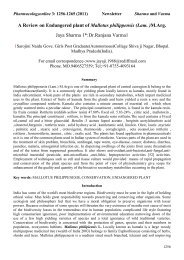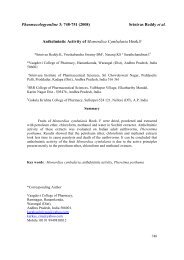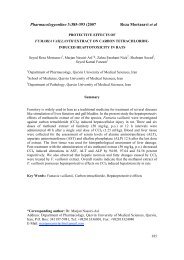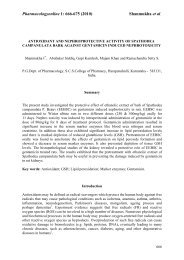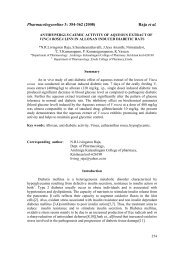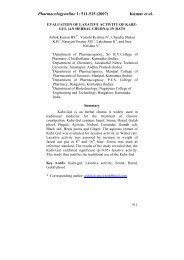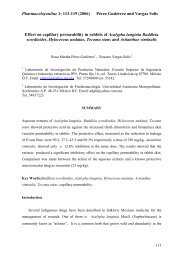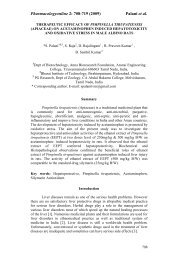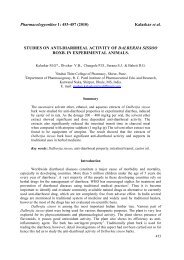Protective Effect of Neoalsomitra Clavigera in Chemical and
Protective Effect of Neoalsomitra Clavigera in Chemical and
Protective Effect of Neoalsomitra Clavigera in Chemical and
You also want an ePaper? Increase the reach of your titles
YUMPU automatically turns print PDFs into web optimized ePapers that Google loves.
Pharmacologyonl<strong>in</strong>e 1: 294-299 (2008) Haldar et al.<br />
PROTECTIVE EFFECT OF NEOALSOMITRA CLAVIGERA<br />
IN CHEMICAL AND STRESS INDUCED GASTRIC MUCOSAL<br />
LESIONS IN RATS<br />
P.K Haldar 1 , Sanjib Bhattacharya 2* , M. K. Zaman 3 , R. Vanlalsiama 3<br />
1 Dept. <strong>of</strong> Pharmaceutical Technology, Jadavpur University, Kolkata 700032, West Bengal, India.<br />
2 R.R.S. College <strong>of</strong> Pharmacy, Amethi 227405, U.P., India<br />
3 Dept. <strong>of</strong> Pharmaceutical Sciences, Dibrugarh University, Dibrugarh 786004, Assam, India.<br />
*Correspond<strong>in</strong>g author: Sanjib Bhattacharya, R.R.S. College <strong>of</strong> Pharmacy, Amethi 227407, U.P.,<br />
India. Phone: +91-9919798896, E-mail: sakkwai@yahoo.com<br />
Summary<br />
<strong>Neoalsomitra</strong> clavigera (Wall) Hutch. (Cucurbitaceae) is a woody climber plant<br />
found <strong>in</strong> south-east Asia <strong>in</strong>clud<strong>in</strong>g north-east India <strong>and</strong> its ripe fruits are used<br />
traditionally <strong>in</strong> India for stomachache, peptic ulcer <strong>and</strong> diarrhea. In present study,<br />
the aqueous extract from the ripe fruits <strong>of</strong> <strong>Neoalsomitra</strong> clavigera was evaluated<br />
for its protective effects on gastric mucosal lesion <strong>in</strong> Wistar alb<strong>in</strong>o rats aga<strong>in</strong>st<br />
acetylsalicylic acid (ASA), ethanol <strong>and</strong> water immersion restra<strong>in</strong>t stress <strong>in</strong>duced<br />
gastric mucosal damage. In each model the cold maceration aqueous fruit extract<br />
was employed at the doses <strong>of</strong> 100 <strong>and</strong> 200 mg/kg body weight, p.o along with the<br />
st<strong>and</strong>ard drug ranitid<strong>in</strong>e hydrochloride at a dose <strong>of</strong> 35 mg/kg, p.o. The extract<br />
exhibited significant reduction <strong>of</strong> gastric mucosal lesions <strong>in</strong> chemical (ASA, <strong>and</strong><br />
ethanol) as well as <strong>in</strong> stress-<strong>in</strong>duced model.<br />
Key words: <strong>Neoalsomitra</strong> clavigera, gastric mucosal damage, ASA, ethanol, water immersion<br />
stress, Ranitid<strong>in</strong>e HCl.<br />
<strong>Neoalsomitra</strong> clavigera (Wall) Hutch. (Cucurbitaceae), called ‘Lalrunga-dawibur’ <strong>in</strong> Mizo is a<br />
woody climber plant species occurr<strong>in</strong>g <strong>in</strong> South-East Asian countries <strong>in</strong>clud<strong>in</strong>g North-East India,<br />
Nepal, Bangladesh, Myanmar, Malaysia <strong>and</strong> <strong>in</strong> Australia. In India it is distributed <strong>in</strong> the hilly<br />
region <strong>of</strong> Arunachal Pradesh, Assam, Meghalaya, Mizoram <strong>and</strong> Sikkim at an altitude <strong>of</strong> around<br />
3000-4000 ft. The ripe fruits <strong>of</strong> N. clavigera are traditionally used by the people <strong>of</strong> Mizoram as<br />
one <strong>of</strong> the most effective medic<strong>in</strong>e for stomachache, peptic ulcer, <strong>and</strong> diarrhea. For the treatment<br />
<strong>of</strong> peptic ulcer the <strong>in</strong>fusion <strong>of</strong> the fruit is taken daily for a few weeks. The fruit thus can be used<br />
for three to four times before the bitterness disappears (1, 2, 3) .<br />
294
Pharmacologyonl<strong>in</strong>e 1: 294-299 (2008) Haldar et al.<br />
Thorough search <strong>of</strong> literature did not reveal any reports <strong>of</strong> biological <strong>in</strong>vestigations carried out on<br />
N. clavigera. The present work therefore, attempts to evaluate the anti-ulcer activity <strong>of</strong> the aqueous<br />
extract from the ripe fruits <strong>of</strong> N. clavigera grow<strong>in</strong>g <strong>in</strong> Mizoram, India to justify its folkloric uses.<br />
Methods<br />
The ripe fruits <strong>and</strong> aerial parts <strong>of</strong> <strong>Neoalsomitra</strong> clavigera (Wall.) Hutch. were collected dur<strong>in</strong>g the<br />
month <strong>of</strong> November 2005 from Th<strong>in</strong>gdawl, Mizoram state, India. The species was identified by the<br />
Botanical Survey <strong>of</strong> India, Eastern Circle, Shillong, India, <strong>and</strong> a voucher specimen (No. DUPS-05-<br />
003) was kept <strong>in</strong> Dept. <strong>of</strong> Pharmaceutical Sciences, Dibrugarh University, Dibrugarh 786004,<br />
India, for future reference. After collection, the fruits were shade dried at temperature 21-24°C <strong>and</strong><br />
ground <strong>in</strong>to coarse powder.<br />
The air dried ripe fruits <strong>of</strong> N. clavigera were extracted with water by cold maceration. Powdered<br />
plant materials (70 g) were macerated with 400 ml <strong>of</strong> water at 21-24°C temperature for 2 days with<br />
frequent shak<strong>in</strong>g. After 2 days, the extracts were filtered <strong>and</strong> to the marc part 300 ml <strong>of</strong> water was<br />
added <strong>and</strong> allowed to st<strong>and</strong> for next two days at same temperature for second time maceration (remaceration)<br />
<strong>and</strong> after two days, aga<strong>in</strong> filtered similarly. The comb<strong>in</strong>ed filtrates (extracts) were<br />
evaporated to dryness <strong>in</strong> a vacuum oven <strong>and</strong> kept <strong>in</strong> a desiccator for future use.<br />
Adult male Wister alb<strong>in</strong>o rats weigh<strong>in</strong>g 180-200 g were obta<strong>in</strong>ed from the animal house <strong>of</strong><br />
Department <strong>of</strong> Pharmaceutical Sciences, Dibrugarh University, Dibrugarh-786004, India.<br />
The animals were grouped <strong>in</strong> polyacrylic cages (38 cm x 23 cm x 10 cm) with not more<br />
than three animals per cage <strong>and</strong> ma<strong>in</strong>ta<strong>in</strong>ed under st<strong>and</strong>ard laboratory conditions<br />
(temperature 25 ± 2 o<br />
C) with dark <strong>and</strong> light circle (14/10 h). They were allowed free access<br />
to st<strong>and</strong>ard dry pellet diet (H<strong>in</strong>dustan Lever, Gwuahati, India) <strong>and</strong> water ad libitum. The<br />
rats were acclimatized to laboratory condition for 10 days before commencement <strong>of</strong><br />
experiment.<br />
For acetyl salicylic acid (ASA) <strong>in</strong>duced gastric ulcer (4) the rats were weighed <strong>and</strong> divided <strong>in</strong>to<br />
four groups each consist<strong>in</strong>g six rats (n = 6). All rats were fasted for 48 h with water ad<br />
lbitum. The first group <strong>of</strong> animals which served as control received distilled water 10<br />
ml/kg body weight p.o. The second group <strong>of</strong> animals which served as st<strong>and</strong>ard, received<br />
ranitid<strong>in</strong>e hydrochloride at the dose <strong>of</strong> 35 mg/kg body weight p.o. (5) . The third <strong>and</strong> fourth<br />
group <strong>of</strong> animals received aqueous extract <strong>of</strong> N. clavigera at the doses <strong>of</strong> 100 mg <strong>and</strong> 200<br />
mg/kg body weight p.o. respectively.<br />
30 m<strong>in</strong>utes after adm<strong>in</strong>istration <strong>of</strong> distilled water, ranitid<strong>in</strong>e hydrochloride <strong>and</strong> test extract<br />
to the four groups as mentioned above, an aqueous suspension <strong>of</strong> ASA at the dose <strong>of</strong> 250<br />
mg/kg body weight was given orally to each rat. After 6 h, the animals were sacrificed by<br />
cervical dislocation; the stomachs were removed <strong>and</strong> opened along the greater curvature.<br />
The stomach was r<strong>in</strong>sed with normal sal<strong>in</strong>e <strong>and</strong> exam<strong>in</strong>ed grossly. The ulcer <strong>in</strong>dex was<br />
evaluated accord<strong>in</strong>g to number <strong>and</strong> severity <strong>of</strong> lesions formed <strong>and</strong> scored us<strong>in</strong>g the<br />
follow<strong>in</strong>g scale (6) .<br />
295
Pharmacologyonl<strong>in</strong>e 1: 294-299 (2008) Haldar et al.<br />
0 = no visible ulcers; 1 = petechial hemorrhage or m<strong>in</strong>ute p<strong>in</strong> po<strong>in</strong>t ulcers; 2 = one or two<br />
small ulcers; 3 = more than two ulcers, ma<strong>in</strong>ly with few large ulcers; 4 = more than two<br />
ulcers, with ma<strong>in</strong>ly large ulcers.<br />
The mean ulcer <strong>in</strong>dices <strong>in</strong> each group were calculated <strong>and</strong> expressed the percentage <strong>of</strong><br />
<strong>in</strong>hibition us<strong>in</strong>g the follow<strong>in</strong>g formula.<br />
(Control mean − Treated mean/ Control mean) × 100 %.<br />
In ethanol <strong>in</strong>duced gastric ulcer (7) the rats were fasted for 18 h <strong>and</strong> deprived <strong>of</strong> water for<br />
12 h before experiment. The rats were divided <strong>in</strong>to four groups (n = 6) <strong>and</strong> received the<br />
drug <strong>in</strong>terventions as described above <strong>in</strong> the ASA experiment. 1 h after the adm<strong>in</strong>istration<br />
<strong>of</strong> st<strong>and</strong>ard <strong>and</strong> test drugs, the animals received ethanol at a dose <strong>of</strong> 1 ml/200g body<br />
weight p.o. After 1 h, the animals were sacrificed by cervical dislocation; the stomachs<br />
were removed <strong>and</strong> opened along the greater curvature, r<strong>in</strong>sed with normal sal<strong>in</strong>e. Then the<br />
gastric mucosa was observed <strong>and</strong> scored as mentioned above.<br />
In stress <strong>in</strong>duced gastric ulcer (8) the rats were fasted for 24 h with water ad libitum. The rats<br />
were divided <strong>in</strong>to four groups (n = 6) <strong>and</strong> received the drug <strong>in</strong>terventions as described<br />
above <strong>in</strong> the ASA experiment. Immediately after adm<strong>in</strong>istration, each rat was immobilized<br />
<strong>in</strong> a cyl<strong>in</strong>drical cage <strong>and</strong> immersed vertically to the level <strong>of</strong> xyphoid process <strong>in</strong> a water<br />
bath for 17 h, ma<strong>in</strong>ta<strong>in</strong>ed at 25 ± 2ºC. Then the animals were killed by cervical<br />
dislocation; the stomachs were removed <strong>and</strong> opened along the small curvature. The<br />
stomach was r<strong>in</strong>sed with normal sal<strong>in</strong>e <strong>and</strong> exam<strong>in</strong>ed for gastric mucosal damage <strong>and</strong><br />
scored as above.<br />
The results are expressed as mean ± St<strong>and</strong>ard Error <strong>of</strong> Mean (SEM). Student’s ‘t’ test was used to<br />
verify the statistical significance at P < 0.05.<br />
Table 1. Inhibition <strong>of</strong> ASA <strong>in</strong>duced gastric ulceration by aqueous extract <strong>of</strong> N. clavigera.<br />
Treatment Dose (mg/kg, p.o) Ulcer <strong>in</strong>dex ± SEM % Inhibition<br />
Control Water, 10 ml/kg,<br />
p.o<br />
3.77 ± 0.21 -<br />
N. clavigera<br />
aqueous extract<br />
100 2.24 ± 0.47 35.26<br />
N. clavigera<br />
aqueous extract<br />
200 1.33 ± 0.72* 64.72<br />
Ranitid<strong>in</strong>e HCL 35 1.06 ± 0.58** 71.88<br />
Number <strong>of</strong> animals per group (n) = 6.<br />
SEM = St<strong>and</strong>ard Error <strong>of</strong> Mean<br />
*p< 0.05, **p < 0.01, compared to control. Degree <strong>of</strong> signicavity was assessed by Student’s ‘t’ test.<br />
296
Pharmacologyonl<strong>in</strong>e 1: 294-299 (2008) Haldar et al.<br />
Table 2. Inhibition <strong>of</strong> ethanol <strong>in</strong>duced gastric ulceration by aqueous extract <strong>of</strong> N. clavigera.<br />
Treatment Dose (mg/kg, p.o) Ulcer <strong>in</strong>dex ± SEM % Inhibition<br />
Control Water, 10 ml/kg,<br />
p.o<br />
3.83 ± 0.19 -<br />
N. clavigera<br />
aqueous extract<br />
100 1.57 ± 0.73* 59.00<br />
N. clavigera<br />
aqueous extract<br />
200 1.39 ± 0.40* 63.70<br />
Ranitid<strong>in</strong>e HCL 35 0.94 ± 0.81** 75.45<br />
Number <strong>of</strong> animals per group (n) = 6.<br />
SEM = St<strong>and</strong>ard Error <strong>of</strong> Mean<br />
*p< 0.05, **p < 0.01, compared to control. Degree <strong>of</strong> signicavity was assessed by Student’s ‘t’ test.<br />
Table 3. Inhibition <strong>of</strong> stress <strong>in</strong>duced gastric ulceration by aqueous extract <strong>of</strong> N. clavigera.<br />
Treatment Dose (mg/kg, p.o) Ulcer <strong>in</strong>dex ± SEM % Inhibition<br />
Control Water, 10 ml/kg,<br />
p.o<br />
3.46 ± 0.64 -<br />
N. clavigera<br />
aqueous extract<br />
100 3.12 ± 0.49 9.82<br />
N. clavigera<br />
aqueous extract<br />
200 1.78 ± 0.51* 48.55<br />
Ranitid<strong>in</strong>e HCl 35 0.67 ± 0.33** 80.63<br />
Number <strong>of</strong> animals per group (n) = 6.<br />
SEM = St<strong>and</strong>ard Error <strong>of</strong> Mean<br />
*p< 0.05, **p < 0.01, compared to control. Degree <strong>of</strong> signicavity was assessed by Student’s ‘t’ test.<br />
Results<br />
The effects <strong>of</strong> aqueous extract from N. clavigera fruits on ASA <strong>in</strong>duced gastric ulcers are shown <strong>in</strong><br />
Table 1. The extract at the dose <strong>of</strong> 100 mg/kg body weight showed <strong>in</strong>hibition aga<strong>in</strong>st ulcer<br />
formation but was found statistically <strong>in</strong>significant. The extract, however at 200 mg/kg dose<br />
significantly (p < 0.05) reduced the ulcerogenic lesions. The st<strong>and</strong>ard drug ranitid<strong>in</strong>e hydrochloride<br />
exhibited significant (p < 0.05) <strong>in</strong>hibition <strong>of</strong> ulcers.<br />
In ethanol <strong>in</strong>duced gastric ulcer model, the effects <strong>of</strong> N. clavigera fruit extract are shown <strong>in</strong> Table<br />
2. The extract at the both test doses afforded significant (p < 0.05) protection aga<strong>in</strong>st ulcer<br />
formation. The st<strong>and</strong>ard drug ranitid<strong>in</strong>e hydrochloride exhibited significant (p < 0.01) <strong>in</strong>hibition <strong>of</strong><br />
ulcers.<br />
In stress <strong>in</strong>duced gastric ulcer model, the effects <strong>of</strong> N. clavigera fruit extract are shown <strong>in</strong> Table 3.<br />
Here, the extract at lower dose (100 mg/kg) showed negligible ulcer <strong>in</strong>hibitory activity. Its higher<br />
dose (200 mg/kg) demonstrated significant (p < 0.05) protection. The st<strong>and</strong>ard drug ranitid<strong>in</strong>e<br />
hydrochloride exhibited marked <strong>and</strong> significant (p < 0.01) protection aga<strong>in</strong>st gastric mucosal<br />
damage.<br />
297
Pharmacologyonl<strong>in</strong>e 1: 294-299 (2008) Haldar et al.<br />
Discussion<br />
Ulcers are caused by an imbalance between aggressive <strong>and</strong> defensive factors <strong>of</strong> the gastric mucosa.<br />
Gastric acid <strong>and</strong> peps<strong>in</strong> make up the <strong>of</strong>fensive factors whose proteolytic effect is buffered by muc<strong>in</strong><br />
production, mucosal glycoprote<strong>in</strong>, cell shedd<strong>in</strong>g, cell proliferation <strong>and</strong> prostagl<strong>and</strong><strong>in</strong>s (9) . Different<br />
therapeutic agents <strong>in</strong>clud<strong>in</strong>g plant extracts have been used to <strong>in</strong>hibit gastric acid secretion or to<br />
boost the mucosal defense mechanisms (10) . In present <strong>in</strong>vestigation, the aqueous extract <strong>of</strong> N.<br />
clavigera ripe fruits was screened for the anti-ulcer activity <strong>in</strong> chemical (ASA, ethanol) <strong>and</strong> stress<br />
(water immersion-<strong>in</strong>duced restra<strong>in</strong>t stress) <strong>in</strong>duced ulcers <strong>in</strong> Wister alb<strong>in</strong>o rats.<br />
Acetyl salicylic acid (ASA) is a potent irreversible prostagl<strong>and</strong><strong>in</strong> biosynthesis <strong>in</strong>hibitor <strong>and</strong> causes<br />
a dose dependent reduction <strong>in</strong> mucosal prostagl<strong>and</strong><strong>in</strong>s (PGE2 <strong>and</strong> PGI2) biosynthesis accompanied<br />
by an <strong>in</strong>crease <strong>in</strong> the areas <strong>of</strong> gastric mucosal damage. The observed gastric mucosal lesions<br />
<strong>in</strong>duced by ASA are due to the deficiency <strong>of</strong> mucosal prostagl<strong>and</strong><strong>in</strong>s (11) . The extract was found to<br />
exhibit a significant anti-ulcer property at higher dose (200 mg/kg) aga<strong>in</strong>st ASA <strong>in</strong>duced gastric<br />
ulcer.<br />
Ethanol <strong>in</strong>duced gastric ulcers have been widely used for the evaluation <strong>of</strong> gastro protective<br />
activity. Ethanol <strong>in</strong>duces ulcers by reduction <strong>of</strong> gastric mucosal blood flow, mucus production,<br />
endogenous glutathione <strong>and</strong> prostagl<strong>and</strong><strong>in</strong> levels. At the same time ethanol <strong>in</strong>creases ischaemia,<br />
gastric vascular permeability <strong>and</strong> back diffusion, histam<strong>in</strong>e release, generation <strong>of</strong> free radicals <strong>and</strong><br />
production <strong>of</strong> leukotrienes (12) . It has been found that oxygen derived free radicals are implicated <strong>in</strong><br />
the mechanism <strong>of</strong> acute <strong>and</strong> chronic ulceration by ethanol <strong>and</strong> scaveng<strong>in</strong>g these free radicals can<br />
play an appreciable role <strong>in</strong> heal<strong>in</strong>g <strong>of</strong> these ulcers (13) . The extract at all test doses exhibited<br />
significant anti-ulcer activity aga<strong>in</strong>st ethanol <strong>in</strong>duced ulceration. This effect may be due to its antioxidant<br />
activity.<br />
Gastro<strong>in</strong>test<strong>in</strong>al erosion is one <strong>of</strong> the consistent f<strong>in</strong>d<strong>in</strong>gs <strong>in</strong> man <strong>and</strong> experimental animals subjected<br />
to different types <strong>of</strong> stress. It has been shown that exposure <strong>of</strong> rats to restra<strong>in</strong>t stress significantly<br />
decreases gastric acid secretion (14) but gastric acid secretion <strong>in</strong>creases towards the pre-stress level<br />
for a few hours when the restra<strong>in</strong>ed animals are subjected to additional water immersion (15) . S<strong>in</strong>ce<br />
the development gastric lesions dur<strong>in</strong>g stress enhances significantly by exposure to water<br />
immersion, the rise <strong>in</strong> acid secretion may be important <strong>in</strong> the aggravat<strong>in</strong>g process <strong>of</strong> lesions dur<strong>in</strong>g<br />
water immersion (16) . The extract also exhibited significant protection aga<strong>in</strong>st stress <strong>in</strong>duced gastric<br />
mucosal lesions.<br />
From the present <strong>in</strong>vestigation it can be concluded that the aqueous extract <strong>of</strong> <strong>Neoalsomitra</strong><br />
clavigera fruits afforded significant anti-ulcer activity aga<strong>in</strong>st chemical <strong>and</strong> stress <strong>in</strong>duced gastric<br />
lesions thereby reduc<strong>in</strong>g mucosal damage. The anti-ulcer effects <strong>of</strong> fruits from N. clavigera can<br />
provide a scientific basis for its traditional uses for stomachache <strong>and</strong> peptic ulcer <strong>in</strong> North-East<br />
India.<br />
Acknowledgement<br />
The authors would like to thank Dr. A. Bhattacharya, Reader <strong>and</strong> Head, Department <strong>of</strong><br />
Pharmaceutical Sciences, Dibrugarh University, Dibrugarh, Assam-786004, India, for his k<strong>in</strong>d help<br />
<strong>and</strong> <strong>in</strong>spiration for the current work.<br />
298
Pharmacologyonl<strong>in</strong>e 1: 294-299 (2008) Haldar et al.<br />
References<br />
1. Hooker JD. The Flora <strong>of</strong> British India. Vol. II. London: William Clower <strong>and</strong> Sons Ltd., 1879:<br />
634.<br />
2. Rozika R, Damdawai R. Medic<strong>in</strong>al Plants (Agri. Extn. Series-26), 1 st ed. New Delhi: Directorate<br />
<strong>of</strong> Agriculture <strong>and</strong> M<strong>in</strong>or Irrigation, Govt. <strong>of</strong> India, 2001: 111-112.<br />
3. Thansanga R. Agriculture <strong>in</strong> Mizoram. Aizawl: Directorate <strong>of</strong> Agriculture, Govt <strong>of</strong> Mizoram,<br />
2000: 102.<br />
4. Kunle OO, Shittu A, Nasipuri, RN, et al. Gastro<strong>in</strong>test<strong>in</strong>al activity <strong>of</strong> Ficus sur. Fitoterapia 1999;<br />
70: 542-547.<br />
5. Paul RK, Jabbar A, Rashid MA. Antiulcer activity <strong>of</strong> Mikania cordata. Fitoterapia 2000; 71:<br />
701-703.<br />
6. Liu XM, Zakaria MNM, Islam MW, et al. Anti-<strong>in</strong>flammatory <strong>and</strong> anti-ulcer activity <strong>of</strong><br />
Calligonum comosum <strong>in</strong> rats. Fitoterapia 2001; 72: 487-491.<br />
7. Holl<strong>and</strong>er D, Tarnawski A, Krause WJ, Gergely H. <strong>Protective</strong> effect <strong>of</strong> sucralfate aga<strong>in</strong>st alcohol<br />
<strong>in</strong>duced gastric mucosal <strong>in</strong>jury <strong>in</strong> the rat: Macroscopic, histologic, ultrastructural <strong>and</strong> functional<br />
time sequence analysis. Gastroenterology 1985; 88: 366-374.<br />
8. Bacchi EM, Sertie JAA. Antiulcer action <strong>of</strong> Styrax camporum <strong>and</strong> Caesalp<strong>in</strong>ia ferra <strong>in</strong> rats.<br />
Planta Med 1994; 60: 118-120.<br />
9. Goel RK, Bhattacharya SK. Gastro<strong>in</strong>test<strong>in</strong>al mucosal defense <strong>and</strong> mucosal protective agents.<br />
Indian J Exp Biol 1999; 29: 701.<br />
10. Goel RK, Sairam K. Antiulcer drugs from <strong>in</strong>digenous sources with emphasis on Musa<br />
sapientum, Tamrabhasma, Asparagus racemosus <strong>and</strong> Z<strong>in</strong>giber <strong>of</strong>fic<strong>in</strong>ale. Indian J Pharm 2002; 34:<br />
100-110.<br />
11. Vane JT. Inhibition <strong>of</strong> prostagl<strong>and</strong><strong>in</strong> synthesis as a mechanism <strong>of</strong> action <strong>of</strong> aspir<strong>in</strong> like drugs.<br />
Nature 1971; 231: 232-236.<br />
12. Glav<strong>in</strong> GB, Szabo S. Experimental gastric mucosal <strong>in</strong>jury, laboratory models reveal mechanism<br />
<strong>of</strong> pathogenesis <strong>and</strong> new therapeutic strategies. FASEB J1992; 6: 825-831.<br />
13. Loguercio C, Taranto D, Beneduce F, Balance VV, V<strong>in</strong>centis A. Glutathione prevents ethanol<br />
<strong>in</strong>duced gastric mucosal damage <strong>and</strong> depletion <strong>of</strong> sulfydryl compounds <strong>in</strong> humans. Gut 1993; 34:<br />
161-165.<br />
14. Brodie DA, Marshall RW, Morneo M. The effect <strong>of</strong> restra<strong>in</strong>t on gastric acidity <strong>in</strong> the rat. Am J<br />
Physiol 1962; 202: 812-814.<br />
15. Hayase M, Tukeuchi K. Gastric acid secretion <strong>and</strong> lesion formation <strong>in</strong> rats under water<br />
immersion stress. Dig Dis Sci 1986; 31: 166-171.<br />
16. Parmar NS, Desai JK. A review <strong>of</strong> the current methodology for the evaluation <strong>of</strong> gastric <strong>and</strong><br />
duodenal anti-ulcer agents. Indian J Pharmacol 1993; 25: 120-135.<br />
299



